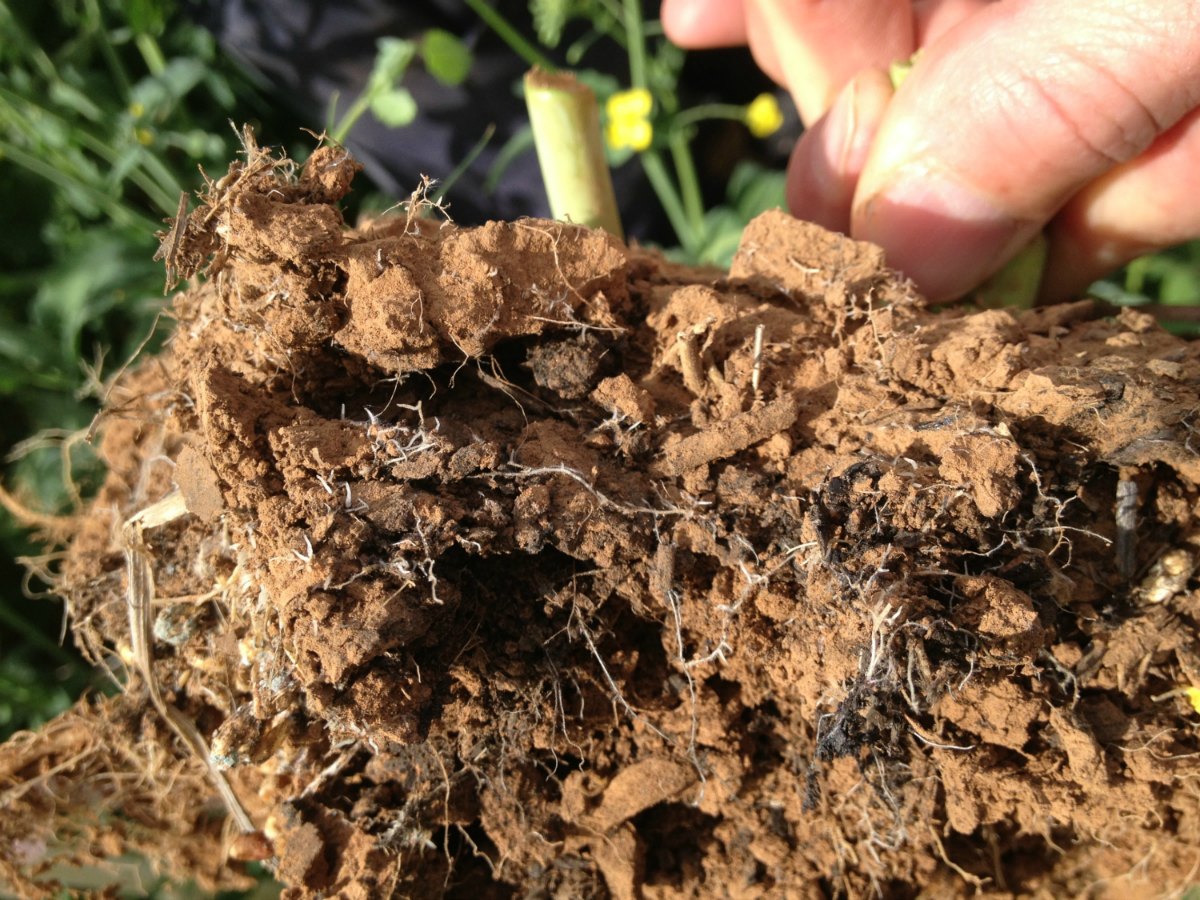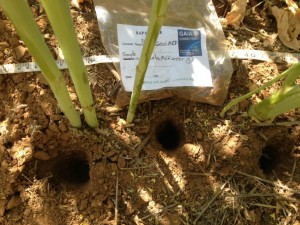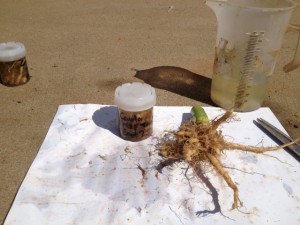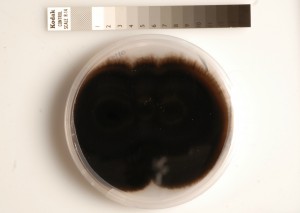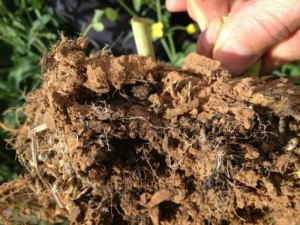I wrote a few weeks back about the impressive initial outcomes of research undertaken with melanised endophytic fungi (MEF) by Sydney University. The trials resulted in soil carbon increases of up to 40% in the university pot trials. What we want to know however is if the findings will translate to the field and can such fungi strains be isolated and packaged to farmers for inoculation of our crops and pasture.
You may recall that researchers proposed a process by which the fungi place stable carbon into the soil – depositing carbon rich aromatic melanin compounds into the anaerobic interior of soil aggregates. The significance of this is that when placed there, the carbon is protected from loss by oxidation or from decay by microbial enzymes. So, it has potential for increasing ‘stable’ soil carbon in cropping systems.
Work at the university involved inoculating soils with subterranean clover in pot trials – the treatment with some strains of which resulted in significant increases in soil carbon. Guy Webb, agronomist at Forbes, picked up on this work and wanted to test this inoculation of broadleaf crops in the field, along with determining if there were any resulting increases in soil carbon over untreated plots. This is with the view that if ongoing field trials are supportive of MEF sequestering carbon, that there may be opportunity to develop a ‘farmer ready, soil carbon sequestration inoculum package capable of reliably, rapidly and significantly increasing soil organic carbon and reducing nitrous oxide emissions in cropping soils”.1
Together with other interested parties, Guy has established Soil C Quest 2031, which ‘is a not-for-profit agricultural organisation whose mission is to improve soil carbon sequestration through research and development of agricultural processes and products that improve current practices’.2 Soil C Quest 2031 has begun the Soil Carbon Inoculum Project, which is the project under which the initial field evaluations have been done. Let’s take a look at these, because I’m sure you’re all eager to know if this is likely to work in the field.
Field Trials
The first of the field trials took the highest carbon sequestering strains of MEF (according to the Sydney University research team’s previous work), and tested them on an actively growing rosette stage canola crop at Forbes, which was being grown by standard industry practice. To inoculate the roots of the canola plants, the Sydney University team took sterilized wheat seed and inoculated it with a mix of strains of living melanised fungi that had sequestered higher soil carbon levels in the pot trials. An untreated sterilized wheat seed was also supplied.
The inoculum (on seed) was placed 5cm deep in the soil (via a shovel) and 20cm away from the base of the canola plant, with the aim of getting the MEF to inoculate directly onto the root system of the canola. After a 30 day period, soil samples were taken 15cm from the base of the plant (to test carbon levels), along with root samples to test for colonisation of the MEF.
Samples were sent back to the Sydney University team for testing.
The rosette stage was chosen as the test period as it is the peak carbon producing period of growth.
Colonisation
Analysis of the roots revealed that the canola plants were successfully inoculated with several strains of the MEF from the inoculum, while the untreated revealed no strains from the inoculum. So, results indicate successful colonisation of the roots. But, the thing we really want to know is did they increase carbon levels?
Soil Carbon Levels
The inoculum treatments supported the outcomes of the University trials, in that they increased soil carbon more than untreated plots. Treated plots increased soil organic carbon levels of 32% over the non-inoculated treatments in the 30 day period of the trial. The increase was from 1.334% to 1.976% SOC3. Keep in mind that this is not soil carbon increase in the whole of the soil, but rather in the active root zone, 15cm from the plant base. A great result none the less.
Guy undertook similar trials in cotton on a property at Trangie, which has not been written up yet, but there was a 12% increase in soil carbon over a 2 month period – another promising result. It may be that, in time, different MEF strains may be identified that work better with different crop species.
I quizzed Guy on why we weren’t achieving such carbon sequestration from the naturally occurring MEF in the soil. He agreed that there are naturally occurring MEF in the soil, but he explained it well in saying that the work of Peter McGee and Mukasa Mugerwa et al at Sydney University has identified the ‘racehorses’ of these fungi – that perform far and above other strains. He likened it to what the industry has done with nitrogen fixing rhizobia and pulses. There are naturally occurring native nitrogen fixing rhizobia, but the strains that we use to inoculate pulses are the racehorses, that provide the most benefit from an N fixing viewpoint.
I also quizzed Guy on whether the MEF would need to be delivered together with a mycorrhizae fungi (given the interaction that was explained in my original post on the workings of MEF and how it interacts with mycorrhizal fungi to sequester carbon), but testing of soils in the central west indicate to Guy that there are already surprisingly inherent good levels of mycorrhizae in these soils.
Also, interestingly, Guy informed me that the strains of MEF being used in the field trials were unaffected by a certain seed fungicidal treatment commonly used.
What does it look like?
You can see the MEF grown on a petrie dish below.
You can also see from the below photo, roots of the inoculated canola. I quizzed Guy on the black material around the roots, wondering if this was related to the fungi, as there is a very apparent difference in the colour of this material compared with the surrounding soil.
“I am not sure what the black material was on the roots, only that it seemed only to appear on the treated roots and not the control roots. It was not measured or tested and so we have no direct evidence as to what it was” Guy explained.
Ichsani Wheeler, phD in soil carbon sequestration explained to me at the carbon conference earlier in the year, that a darkening of the soil was a reflection of increased microbial activity, not necessarily an increase in carbon.
Farmer Ready package
I suppose that convenient and possible forms of delivery might be as a seed treatment or as a pelletised form to be placed with or below the seed of a crop. The Not for Profit Soil C Quest 2031 is seeking funds to further research about MEF and potential carbon sequestration. If more extensive field trials prove to be supportive of the initial results, Soil C Quest 2031 want to take MEF further to a form where it can be readily delivered to farmers in Australia and eventually internationally.
You can contact Guy Webb if you have any ideas that may help with this funding.
Guy Webb – guy@gaia2112.com.au
I have made this post public in the hope that you might share this with your networks and someone may come across it that can help with the funding of the project, as this could prove to be a MASSIVE benefit to the whole broadacre farming industry. Being a not for profit organisation – Soil C Quest 2031 would be delivering any potential product to the farming community at cost recovery level.
While melanised endophytic fungi may prove to be a really significant and highly beneficial development for the farming industry, we must still consider this in the context of a biological approach to farming and grazing. It is a myriad of soil microbes that will assist us in accessing the full spectrum of nutrients, that will give our plants optimal health and disease and pest resistance. We must bring ‘life’ back into our paddocks.
What do you think the successful delivery of MEF to crops would mean to your broadacre farming system?
References
1&2. Soil Carbon Inoculum Project – Prospectus and Strategic Plan. Soil C Quest.
3. Webb. G,(2013). 2103 Field Evaluation Experiment Forbes NSW Australia. Soil C Quest 2031 Soil Carbon Inoculum Project.

